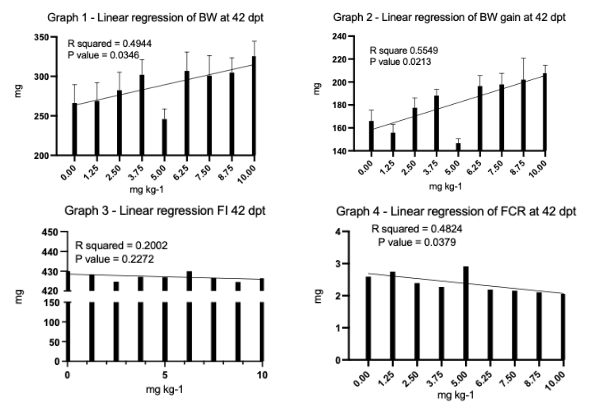DOSE-DEPENDENT EFFECT OF A BLEND OF NUCLEOTIDES ON ZEBRAFISH Danio rerio GROWTH PERFORMANCES
Introduction
Challenges such as disease and environmental stressors represent a relevant threat to fish welfare and farm economic sustainability. Prophylaxis and good farming practices are important strategies to ensure fish welfare in farm conditions and reduce economic losses. Correct fish nutrition and feeding protocols are also key actions for a holistic approach to modern aquaculture production.
b-glucans, Mannano Oligo-Saccharides (MOS), antioxidants and other functional feed ingredients are more and more used in aquaculture. Unfortunately, their solely feed-inclusion is not sufficient to improve fish health and welfare and an appropriate combination of these ingredients is still necessary. This is also the case of nucleotides, a category of molecules characterized by different bioactivity and functions. Nucleotides are essential components of DNA and RNA and are involved in various physiological processes, including growth and immunity (Hossain et al., 2020).
The aim of this study was to investigate the dose-dependent effects of the feed inclusion of a specific blend of nucleotides, specifically formulated for aquaculture application, on fish growth performances. Zebrafish (Danio rerio) was used as animal model.
Materials and methods
The study was carried out at the Zebrafish Facility of the Department of Veterinary Science, University of Pisa (Italy). Protocol and experimental design were approved by the Ethics Committee for Animal Welfare and Use of the University of Pisa and by the Italian Ministry of Health (code: B290E.N.LN2.).
One hundred-eighty fish (102,3±26,43; m±ds) were uses to carry out the trial. The fish were divided into nine dietary treatments (20 fish per treatment), each one characterized by an increasing inclusion level of a specific bleand of nucleotide (Nucleo+ Marfeed, Miavit GmbH, Essen), as follow: 0, 1.25, 2.5, 3.75, 5, 6.75, 7.5, 8.75 and 10 g/kg. Water temperature was set at 28 °C, photoperiod was 12/12 h L/D and the feed was distributed ad libitum, 4 time per day (at 8, 11, 14 and 17), following the “five minutes rule” described by Lawrence (2007).
On days 0, 14, 28 and 42, each fish was slightly anesthetized (MS-222 Sigma, St. Louis, USA), photographed for further individual identification and weighted. Individual indentification was performed as already described by Fronte et al., (2021). Furthermore feed intake (FI) was measured, BW gain (BWg) calculated as difference between two following time points, and Feed Conversion Rate (FCR) calculated as FI/BWg.
The linear regression of final BW, BW gain, FI and FCR was performed to investigate the dose-reaponse effect of the considered treatments and parameters.
Results and Discussion
Excepted for FI, all the other considered parameters showed a significative dose-dependent effect. In detail, at the end of the experiment fish BW (Graph 1) was linearly enhanced (R squared 0.4922; P = 0.0346) by the dietary supplementation with the considered blend of nucleotides. Only exception was observed for the fish treated with 5 mg kg-1 of nucleotides, which reached the lowest BW, with that not following the trend showed by the other groups. Similarly, also BWgain (Graph 2) linearly increased (R squared 0.5549; P = 0.0213). As already mentioned, FI (Graph 3) did not responded to the dietary supplementation (R2 0.2002; P = 0.2272), while FCR (Graph 4) linearly decrased according to the nucleotides supplementation (R2 0.4824; P = 0.0379).
In a previous study (Licitra et al., submitted for publication) carried out on a transgenic zebrafih model (Tg(mpeg1:EGFP)) an immunity enhancement effect was described (Licitra et al., submitted for publication). In present study, the same blend of nucleotides showed also a significant positive effects on fish growth. This effects seems to be linearly correlated to the feed inclusion rate. As described by Hossein et al. (2020), also other authors have already observed similar effects. However, the results of the present study suggest not toxic effect even at the higher dosage (10 mg kg-1), but also that already 3.75 mg kg-1 may ehert significant effects on fish growth.
Conclusion
The aim of the present study was to define the possible efficacy of a blend of nucleotides, specifically formulated for aquaculture application, and the most appropriate dosage, on fish growth performances. The results showed a linear enhancement of the growth performances, starting from a dosage of 3.75 mg kg-1 of feed. Also, no toxic effects were observed at higher dosages, the highest tested dosage (10 mg kg-1) showing the best perfomances. Therefore, the results suggest a signicant efficacy of the tested blend of nucleotides, without evidences of possible toxicity effects.
References
Hossain, S., Koshio, S., Kestemont, P.. Recent advances of nucleotide nutrition research in aquaculture: a review. Reviews in Aquaculture (2020) 12, 1028–1053 doi: 10.1111/raq.12370
Lawrence, C. The husbandry of zebrafish (Danio rerio): A review. Aquaculture (2007) 269, 1–20. doi:10.1016/j.aquaculture.2007.04.077
Fronte, B., Licitra, R., Bibbiani, C., Casini, L., De Zoysa, M., Miragliotta, V., Sagona, S., Coppola, F., Brogi, L., Abramo, F. Fishmeal Replacement with Hermetia illucens Meal in Aquafeeds: Effects on Zebrafish Growth Performances, Intestinal Morphometry, and Enzymology. Fishes 2021, 6, 28. https://doi.org/10.3390/fishes 6030028
Licitra, R., Sangiacomo, C., Trombetta L., Naef , V., Marchese, M., Fronte, B. Nucleotides bath promotes fish development and health: insights from Zebrafish and Gilthead Seabream larvae. Aquaculture Research (under revision)
